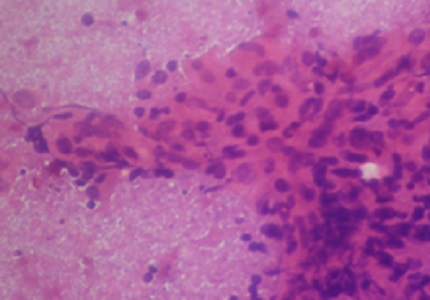Spectrum of cytological finding in superficial lymphnode enlargement in a tertiary care center-retrospective study
Abstract
Introduction: Lymphadenopathy refers to lymph nodes that are abnormal in size, consistency or number. It is one of the commonest and significant clinical presentations of patients, attending the outdoor clinics in most hospitals. Superficial lymphadenopathy ranked among the most common clinical findings encountered in the etiology of lymph nodes enlargement range from spectrum of infections, reactive hyperplasia to malignant diseases. Diagnosing these lesions poses a major challenge to the clinicians. FNAC is an easy, safe, reliable, rapid and inexpensive method for diagnosing enlarged lymph nodes with a high degree of accuracy. The aim of our study is to study and evaluate the spectrum of cases of superficial lymph node enlargement in our region.
Materials and methods: The retrospective study was done in the cytological section of the department of pathology in our hospital over a period of two years. Patients who visited the OPD of our hospital, with complaints of lymph node enlargement weresent for FNAC for proper diagnosis. The data were retrieved, compiled, summarized and statistically analyzed.
Results: Of the 770 cases studied, the most common cause of lymphadenopathy was reactive lymphadenitis with 438 cases (56.8%). The next common diagnosis was found to be granulomatous lymphadenitis with 197 cases (25.5%) followed by suppurative lymphadenitis in 68 cases (8.8%), metastatic lymphadenopathy in 61 cases(7.9%) and malignant lymphoma in 6 cases (0.7%).
Conclusion: FNAC is an easy, simple, safe and inexpensive method of diagnosing lymph node lesions.
Downloads
References
2. Vasilj A, Katovic SK. Fine needle aspiration cytology of head and neck lymph nodes in a ten -year period – single center experience. Acta Clin Croat. 2015 Sep; 54(3) :315-8.
3. Attaullah M, Shah W, Pervez SN, Khan S, Jehan S, Rahim S. Cytomorphological pattern of superficiallymphadenopathy. Gomal J Med Sci. 2014 oct-nov;12 (4): 197-200.
4. Pandey P, Dixit A, Mahajan NC. The diagnostic value of FNAC in assessment of superficial palpable lymph nodes: a study of 395 cases. Al Ameen J Med Sci. 2013 Oct-Dec; 6(4) :320-7.
5. Kochhar AK, Puri PL, Kochhar S. Role of fine needle aspiration cytology in assessment of cervical Lymphadenopathy. International Journal of Medical Research and Review.2016 June; 4(6): 876-80. doi: 10.17511/ijmrr.2016.i06.03.
6. Stewart CJR, Duncan JA, Farquharson M, Richmond J. Fine needle aspiration cytology diagnosis of malignant lymphoma and reactive lymphoid hyperplasia. J ClinPathol 1998 March;51(3):197–203.
7. Gaur R,WoikeP.Spectrum of Cytological Findings In Patients with Superficial Lymphadenopathy: A Five Year Retrospective Study.JMSCR 2015 Oct;3(10) :7933-9.doi: http://dx.doi.org/10.18535/jmscr/v3i10.37.
8. Steel BL, Schwartz MR, Ramzy I. Fine needle aspiration biopsy in the diagnosis of lymphadenopathy in 1, 103 patients. Role, limitationsand analysis of diagnostic pitfalls. Acta Cytol. 1995 Jan-Feb;39(1):76-81.
9. Mohanty R, Wilkinson A. Utility of Fine Needle Aspiration Cytology of Lymph. IOSR Journal of Dental and Medical Sciences. 2013 July- Aug;8:(5)13-18.
10. Chute DJ, Stelow EB. Cytology of head and neck squamous cell carcinoma variants. DiagnCytopathol. 2010 Jan;38(1):65-80. doi: 10.1002/dc.21134. [PubMed]
11. Ghartimagar D, Ghosh A, Ranabhat S, Shrestha MK, Narasimhan R, Talwar OP. Utility of fine needle aspiration cytology in metastatic lymph nodes Journal of Pathology of Nepal. 2011 Oct; 1(2):92 -5.
12. Biradar SS, Masur DS. Spectrum of Lymph Node Lesions by Fine Needle Aspiration Cytology: A Retrospective Analysis. Annals of Pathology and Laboratory Medicine. 2017 May-June;4(3): 264-7.doi: 10.21276/apalm.1355.
13. Giri S, Singh K. Role of fine needle aspiration cytology in evaluation of patients with superficial lymphadenopathy Int J Biol Med Res. 2012 ; 3(4): 2475-9.
14. TapaniTikkakoski, T. Siniluoto, A. Ollikainen, M. Päivánsalo, P. Lohela M.Apaja-Sarkkinen. Ultrasound-Guided Aspiration Cytology of Enlarged Lymph Nodes Acta Radiologica.1991;32(1):53-6.doi:http://dx.doi.org/10.3109/02841859109177508.
15. Arakeri S, Gandhi N. Prospective Study of Fine Needle Aspiration Cytology of Lymph Nodes of The Head And Neck Region over a 2 Year Period with Histopathological Correlation. Indian Journal of Research 2014; 3(2) 229-31.



 OAI - Open Archives Initiative
OAI - Open Archives Initiative


